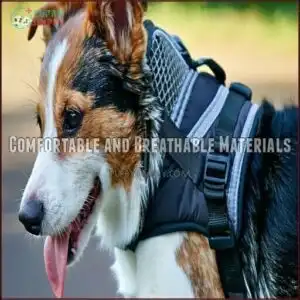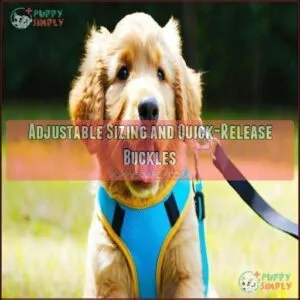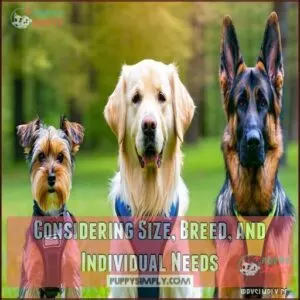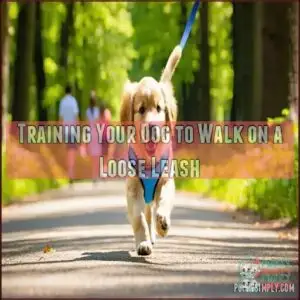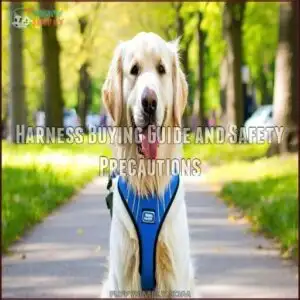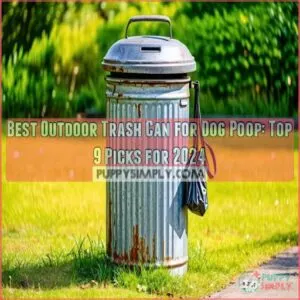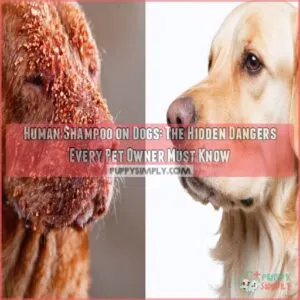This site is supported by our readers. We may earn a commission, at no cost to you, if you purchase through links.
 If your dog pulls like they’re training for a sled race, the best dog harnesses to stop pulling can make a world of difference.
If your dog pulls like they’re training for a sled race, the best dog harnesses to stop pulling can make a world of difference.
No-pull harnesses, like the Rabbitgoo No Pull Dog Harness or the PetSafe Easy Walk Harness, use front-clip designs to steer your dog gently and reduce pulling.
Look for features like padded straps for comfort, adjustable sizing for a snug fit, and durable materials to handle those zoomies.
Some options, like the Ruffwear Front Range Harness, offer extra perks like reflectivity for safety.
Find one that suits your dog’s size and behavior, and leash walks might just feel fun again!
Table Of Contents
- Key Takeaways
- What Causes Dogs to Pull on Leashes
- No-Pull Technology and How It Works
- Key Features of Effective No-Pull Dog Harnesses
- Top 9 Best Dog Harnesses to Stop Pulling
- Choosing The Right No-Pull Harness for Your Dog
- Training Your Dog to Walk on a Loose Leash
- Safety and Effectiveness of No-Pull Harnesses
- Harness Buying Guide and Safety Precautions
- Frequently Asked Questions (FAQs)
- Are harnesses bad for dogs that pull?
- How to choose a harness for a dog that pulls?
- How do I choose the best no-pull dog harnesses?
- How to choose a dog harness?
- What is the best harness to stop a dog from pulling?
- What is the #1 trick to stop your dog from pulling on the leash?
- What is the best aid to stop a dog pulling?
- What dog harness does Peta recommend?
- What is the best type of harness for a dog that pulls?
- What is the #1 trick to stop your dog pulling on the leash?
- Conclusion
Key Takeaways
- Look for a no-pull harness with a front-clip leash attachment to redirect pulling and give you more control.
- Choose harnesses with padded straps, adjustable sizing, and breathable materials to ensure your dog’s comfort and prevent chafing.
- Reflective features or bright colors are essential for nighttime or low-light walks to keep your dog visible and safe.
- Pair your harness with consistent training and positive reinforcement to reinforce good leash manners and enjoy stress-free walks.
What Causes Dogs to Pull on Leashes
Dogs pull on leashes because it’s natural for them to explore and follow exciting smells, sights, or sounds.
Without proper training, they don’t understand leash manners, which makes pulling a common habit.
Understanding Canine Instincts and Behavior
Dogs pull because it’s hardwired into their instincts. It’s not stubbornness—just natural drives like pack mentality or breed predispositions to chase and lead.
Pulling isn’t stubbornness—it’s instinct. Dogs naturally chase, explore, and lead, driven by scents, sights, and their adventurous nature.
Leash pulling often starts from instincts, not bad behavior.
- They want to explore every scent, sound, or squirrel.
- Excitement explodes when they step outside.
- Miscommunication about dominance creates pulling habits.
Understanding canine communication helps with dog behavior modification and training.
Environmental Factors and Stimulation
Stepping into a walk environment can feel like an adventurous scavenger hunt for your pup.
New scents, loud noises, and bustling activity all contribute to sensory input overload, triggering leash pulling. Socialization opportunities—like meeting other dogs or exploring fresh areas—further their excitement.
Without mental enrichment or proper guidance, leash freedom can quickly spiral into chaos. Dog walking becomes a tug when overstimulation takes over.
Using a no-pull harness can help balance control and comfort during these moments, offering better management of dog behavior. Pair it with consistent dog training and leash walking tips to improve their outdoor manners.
This approach can lead to more enjoyable walks, reducing the stress associated with overstimulation and leash pulling, while promoting a more positive experience for both the dog and the owner, through consistent training.
Lack of Training and Leash Etiquette
Training your pup isn’t a sprint—it’s a marathon full of small wins.
A lack of basic obedience leads to pulling, but consistent commands and leash manners make walks enjoyable.
Focus on these steps:
- Teach loose leash walking early.
- Use a training harness for control.
- Start with early socialization.
- Implement dog walking tips daily.
- Consider professional trainers for consistent results.
No-Pull Technology and How It Works
No-pull technology helps reduce pulling by redirecting your dog’s attention and controlling their movements.
It works using front leash attachments or gentle pressure points to guide your dog without causing pain, utilizing gentle pressure points.
Directional Collars and Harnesses
Is your dog pulling like they’ve got somewhere to be? Try directional collars and harnesses! These tools come with a front-clip design that gently steers your pup back on track without the choking or stress of correction collars. It’s like guiding them with a friendly nudge.
- Halter effectiveness: Encourages natural, calm walking by redirecting forward force.
- Front clip pros: Offers better control without causing harm.
- Back clip cons: Avoids encouraging pulling like traditional back-clip systems.
Remember, fit matters! A secure yet comfy harness boosts both safety and control.
Head Halters and Their Functionality
Head halters, like the Gentle Leader, gently guide your dog by steering their head instead of the body, giving you more control.
Proper halter fitting is key for comfort and safety. These directional collars are great for training methods focused on positive reinforcement.
However, dog acceptance varies, so start slow. One key to success is rewarding good behavior consistently during training.
Head halters reduce pulling without harsh correction collars or positive punishment, making them a humane choice in dog training techniques.
Correction Collars and Their Risks
While correction collars like prong, chain, or choke collars may look effective, they carry serious risks.
Collar injuries such as bruises, tracheal damage, or nerve harm are common, and these tools often link to behavioral impacts like fear or aggression.
Training repercussions also include stress and mistrust, leading experts to view them as unethical.
Instead, consider humane alternatives like no-pull harnesses.
These provide control without the risks, using positive punishment-free methods that make walking enjoyable for both you and your pup, promoting a more enjoyable experience.
Key Features of Effective No-Pull Dog Harnesses
When choosing a no-pull dog harness, you’ll want one that’s comfortable, adjustable, and easy to use.
Look for features like soft materials, secure buckles, and front leash attachments to help guide your dog without causing discomfort.
Comfortable and Breathable Materials
In terms of comfort, breathable harness materials make all the difference.
Look for a padded dog harness made with soft, durable fabrics.
Here’s the breakdown:
- Mesh Breathability: Keeps dogs cool on warm days.
- Wool Comfort: Perfect for cozy winter walks.
- Chafing Prevention: Padding types like neoprene prevent irritation.
These materials guarantee a comfortable dog harness that’s both functional and long-lasting for all adventures.
Consider a harness with enhanced airflow design for ideal comfort.
Adjustable Sizing and Quick-Release Buckles
Finding the right fit for your dog harness can feel like tailoring a suit—comfort matters.
Look for adjustable straps to match your pup’s size perfectly. Quick-release buckles add convenience, helping you gear up fast while guaranteeing secure latching.
Prioritize buckle durability and safety features. Many owners find an adjustable fit harness makes all the difference.
Use sizing charts for tips on proper dog harness adjustments and confirm every walk feels snug but free.
Underbody Protection and Compression Features
A good no-pull harness balances comfort and pulling prevention.
Look for underbody features like velvet protection to reduce chafing and compression effectiveness to prevent harness slippage.
A well-fitted dog harness also stops leg soreness by evenly spreading pressure.
Many owners seek solutions for harness-related discomfort.
Designed to curb pulling, these harnesses keep walks stress-free for you and your pup while preventing discomfort.
These harnesses are designed to curb pulling, which makes them ideal for pet owners.
The key benefit of using such a harness is that it provides stress-free walks for both the owner and the dog.
Top 9 Best Dog Harnesses to Stop Pulling
Finding the right harness can make walks enjoyable while keeping your dog safe and under control.
Here are nine of the best no-pull harnesses, offering options for dogs of all sizes and pulling habits.
1. No Pull Dog Harness with Handle
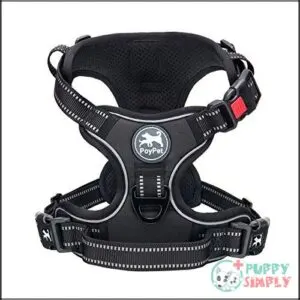
Imagine this scenario: you’re out walking your dog, and they suddenly lunge toward a squirrel—but you’re ready.
Out for a, your dog lunges at a squirrel, but with the right harness, managing the moment feels effortless.
The No Pull Dog Harness with Handle makes moments like these manageable. This harness evenly spreads pressure across your dog’s chest, preventing choking while providing total comfort thanks to its breathable mesh design.
Its padded handle isn’t just for emergencies—it’s perfect for guiding your dog in crowded areas or lifting them if needed. With adjustable straps, you’ll get a snug, secure fit, even as your dog grows.
Reflective stitching makes nighttime strolls stay safe, while durable construction holds up to daily adventures. Walks just got easier, safer, and stress-free!
Best For: Dog owners looking for a safe, comfortable, and adjustable harness to reduce pulling and ensure control during walks or adventures.
- May require initial adjustment for proper fit.
- Some dogs might need time to adapt to new harness design.
- Handwashing required for rich colors to prevent bleeding on lighter coats.
- Evenly distributes pressure to prevent choking and discomfort.
- Adjustable straps for a secure fit across various breeds and sizes.
- Reflective stitching for enhanced visibility during night walks.
2. Rabbitgoo No Pull Dog Harness
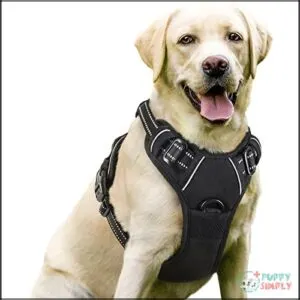
Taking your dog for a walk shouldn’t feel like a workout. The Rabbitgoo No Pull Dog Harness helps you regain control with its smart design.
It features two metal leash rings—one on the chest to discourage pulling and one on the back for relaxed strolling. Your dog’s comfort is no afterthought.
The breathable, padded mesh keeps them cool and comfy on any adventure. Reflective strips give you peace of mind during evening walks, boosting visibility in low light.
Adjustable straps make it easy to achieve a snug, secure fit for medium to large breeds like Golden Retrievers or German Shepherds. Built for durability and safety, Rabbitgoo guarantees every outing feels enjoyable—tug-free!
Best For: Medium to large dog breeds like Golden Retrievers, German Shepherds, and Labradors that need a comfortable, no-pull harness for walks or training.
- Two leash rings for better control, with a no-pull design to reduce tugging.
- Comfortable padded mesh and adjustable straps for a secure fit.
- Reflective strips for enhanced visibility during nighttime use.
- Not suitable for small dog breeds.
- Requires measuring your dog beforehand to ensure proper fit.
- Reflective strips should not replace other safety measures in low light.
3. Freedom No Pull Dog Harness
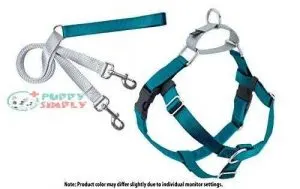
The Freedom No Pull Dog Harness by 2 Hounds Design is like a blend of strength and comfort, making it a solid option to curb pulling.
Its dual connection points—front and back—give you greater control during walks, while the four adjustable straps guarantee a snug fit.
The Swiss velvet lining helps prevent chafing, so your dog stays comfortable, even on longer adventures.
Reflective accents boost visibility for evening strolls, adding an extra layer of safety.
Made with durable nylon and stainless steel hardware, it’s built to last, even with strong pullers.
While it greatly reduces pulling, some pet owners report it may not completely eliminate the behavior for every dog.
Best For: Pet owners seeking a comfortable, durable, and adjustable harness to help manage dogs that pull on walks.
- Dual connection points for better control.
- Velvet lining reduces chafing for added comfort.
- Durable materials built to last with strong pullers.
- May not completely eliminate pulling for all dogs.
- Some dogs may experience skin irritation from the material.
- Mixed reviews on effectiveness depending on individual dogs’ behavior.
4. PetSafe Gentle Leader Dog Headcollar
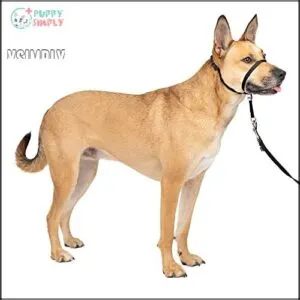
If your dog’s walks feel more like a game of tug-of-war, the PetSafe Gentle Leader Dog Headcollar might just be your game-changer.
Designed by veterinary behaviorists, it fits comfortably around your dog’s nose and redirects their attention back to you when they pull.
The padded neoprene nose loop guarantees comfort, while the adjustable straps make it easy to secure the perfect fit.
Lightweight and easy to put on, it’s a great tool for managing even the strongest pullers.
While some dogs may need time to adjust, with patience and proper fitting, the Gentle Leader reduces pulling and also strengthens your connection with your dog.
Best For: Owners of dogs, especially large breeds, who struggle with pulling during walks.
- Reduces pulling and promotes better leash manners.
- Comfortable fit with padded neoprene nose loop.
- Durable and easy to adjust for various dog sizes.
- Requires gradual introduction for some dogs.
- Not suitable for dogs with respiratory or nasal issues.
- Does not teach loose leash walking independently.
5. Embark Urban Dog Harness
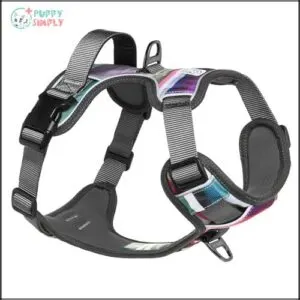
Tired of battling your dog’s pulling habit every time you grab the leash?
The Pioneer Urban Dog Harness is built to make walks enjoyable again. Made with durable Oxford fabric and military-grade nylon, this harness balances strength with lightweight comfort.
Reflective strips guarantee safety, even during nighttime strolls, while the padded design helps prevent chafing.
With both front and back leash attachments, you’ll have the flexibility to guide your pup effortlessly, whether for training or casual walks.
Adjustability is a standout feature, providing a snug, secure fit for dogs of all sizes. Easy to put on and built to last, the Pioneer harness transforms walks into a stress-free experience for both you and your furry friend.
Best For: Owners of small dogs who want a no-pull harness with enhanced visibility, comfort, and durability for everyday walks or outdoor activities.
- Made with durable materials like Oxford fabric and military-grade nylon.
- Features reflective strips for safe nighttime walks.
- Adjustable design ensures a snug and comfortable fit.
- Limited size range may not fit very large dogs.
- Some users may find it heavier compared to simpler harnesses.
- Requires proper adjustment to avoid chafing.
6. PetSafe Easy Walk No Pull Harness
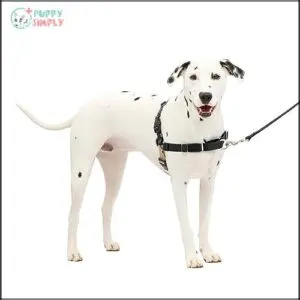
Looking for a way to stop your dog from tugging during walks?
The PetSafe Easy Walk No Pull Harness could be just what you need. Designed by a veterinary behaviorist, it features a patented Martingale loop on the chest that gently redirects your dog’s focus back to you without choking or gagging them.
This lightweight harness uses quick-snap shoulder straps for easy adjustments and a comfortable fit. It’s especially handy if you’re trying to improve leash manners with a strong puller.
While larger dogs might experience some sagging, this harness has proven effective for many pet parents. Give it a try—it might just make walking your dog more enjoyable for both of you!
Best For: Pet parents looking to train their dog to stop pulling gently and without choking during walks.
- Patented Martingale loop design gently redirects pulling behavior.
- Lightweight and breathable for added comfort during walks.
- Quick-snap straps for easy fitting and adjustment.
- Sagging issues may occur with larger dogs, affecting functionality.
- May hinder natural gait or shoulder movement in some dogs.
- Not recommended for young, growing dogs due to front clip-only design.
7. Kurgo Tru Fit Smart Dog Harness
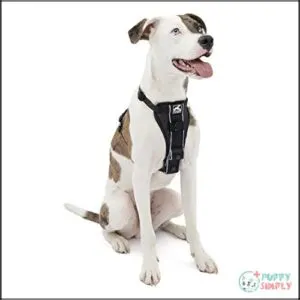
Got a pup that pulls like they’re training for a sled team? The Kurgo Tru-Fit Smart Harness might just be your new best friend.
With five adjustable points, it guarantees a snug fit customized to your dog’s unique shape, making it both secure and comfortable. Quick-release buckles make putting it on or taking it off a breeze—because wrangling a wiggly dog can be tricky enough!
This harness features both front and back D-ring leash attachments, giving you options for no-pull training or casual walks.
Plus, it includes a seatbelt tether to keep your furry co-pilot safe during car rides. While some find the front adjustments a bit finicky, with patience, this harness delivers versatility and reliability.
Best For: Active dog owners seeking a versatile, adjustable harness for walking, running, and car travel safety.
- Multiple adjustment points ensure a secure and comfortable fit.
- Front and back D-rings allow no-pull training and regular walking options.
- Lightweight and padded for all-day comfort during activities.
- Front adjustments may be tricky for some users.
- Limited color options available.
- Seatbelt tether compatibility may vary by car model.
8. Ruffwear Front Range Dog Harness
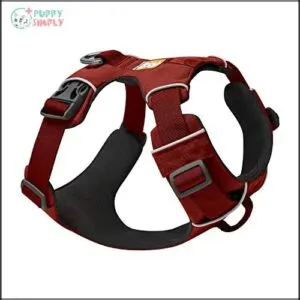
The Ruffwear Front Range Dog Harness is like the Swiss Army knife of dog gear—versatile, comfy, and built to last.
It’s perfect for everything from quick walks to hiking trails. With two leash attachment options, it gives you the flexibility to manage pulling with ease.
The foam-padded chest and belly panels provide all-day comfort, even for active pups.
You’ll appreciate the bright, reflective trim that keeps your dog visible in low light, and the easy-access ID pocket adds a nice touch of convenience.
Thanks to its lightweight, durable construction and four adjustable straps, this harness molds snugly to your dog’s shape. Whether pulling or exploring, it’s all about control with zero compromise on comfort.
Best For: Active dog owners seeking a durable, comfortable harness for walks, hikes, and outdoor adventures.
- May not fit smaller dogs evenly despite adjustable straps.
- Requires measuring the dog carefully for a proper fit.
- Reflective trim may dull with heavy use over time.
- Foam-padded chest and belly panels for all-day comfort.
- Two leash attachment options for flexibility and control.
- Reflective trim enhances visibility in low-light conditions.
9. Blue Mesh No Pull Dog Harness
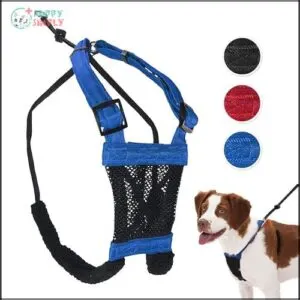
The Blue Mesh No Pull Dog Harness offers a practical mix of comfort and control, making it a smart pick for reducing pulling during walks.
Its design features padded restraint sleeves and a flexible mesh chest panel, which allows your dog to move naturally while staying secure. These materials also prevent chafing, ensuring your pup stays happy even on longer adventures.
Durability is another highlight—this harness is built to handle those surprising squirrel chases! Plus, it’s machine washable, so cleanup after a muddy outing is a breeze.
However, it mightn’t be ideal for pups with larger heads, as the fit could be tricky. For most dogs, though, this is a solid option that blends safety with functionality in a stylish package.
Best For: Dogs of all sizes who need a comfortable, breathable, and no-pull harness for everyday walks and adventures.
- Padded restraint sleeves and breathable mesh provide maximum comfort.
- Durable materials and machine washable for easy maintenance.
- Adjustable straps ensure a secure and custom fit.
- May not fit dogs with larger heads comfortably.
- Some dogs may take time to adjust to the design.
- Lightweight design might not suit extremely strong pullers.
Choosing The Right No-Pull Harness for Your Dog
Picking the right no-pull harness makes walking your dog safer and more enjoyable.
Consider your dog’s size, breed, and specific needs to find one that fits comfortably and works effectively.
Considering Size, Breed, and Individual Needs
Choosing the right no-pull harness starts with your dog’s unique traits. Tailor the choice to their size, breed predispositions, and activity level. A poorly fitted harness won’t prevent pulling and might even cause discomfort.
- Sizing and Fit: Verify it’s adjustable and snug without pinching.
- Activity Level: High-energy dogs need durable harnesses for adventures.
- Individual Temperament: Some dogs need softer materials for comfort.
Match the harness to their quirks for pulling prevention!
Evaluating Comfort, Functionality, and Ease of Use
After figuring out your dog’s size and breed, think about comfort and usability.
A well-made dog harness should have breathable materials for all-day walks, adjustable straps to fit snugly without chafing, and secure buckles that won’t fail under pressure.
Look for a sturdy handle that offers extra control during pulling prevention.
A front clip harness can help with leash training while spreading pressure evenly.
These harnesses offer better comfort and safety compared to traditional collars.
It’s like picking gear that’s comfy for both you and your pup, considering better comfort and ensuring safety for a pleasant experience.
Additional Features and Accessories
Great dog gear isn’t just practical — it makes walks smoother.
Look for features like:
- Handles for quick control during tricky moments.
- Reflective strips to boost visibility on evening strolls.
- Leash attachments that let you switch between training and casual modes.
- ID tag slots or extra storage for convenience.
These thoughtful dog accessories add safety, flexibility, and ease, keeping your walks worry-free.
Training Your Dog to Walk on a Loose Leash
Teaching your dog to walk on a loose leash takes patience and the right approach.
By using positive reinforcement and staying consistent, you can turn stressful walks into enjoyable adventures for both of you.
Positive Reinforcement Techniques and Strategies
Leash training doesn’t have to feel like a tug-of-war.
Positive reinforcement is fantastic for teaching loose leash walking.
Equip yourself with a no-pull harness to keep your dog comfortable while you work together.
Use treat rewards or toy motivation to encourage good behavior.
Try clicker training to mark correct actions instantly, and pair it with verbal praise like “Good job!”
Timing matters—reward your dog right when their leash stays slack.
Shaping behavior patiently will make dog walking safer, smoother, and way more enjoyable for both of you.
Remember that operant conditioning fundamentals are key to success.
Addressing Pulling Behavior and Redirecting Attention
Does your dog act like a sled dog on a mission? Mastering leash reactivity takes calming techniques and persistence.
With a no-pull harness, you’ll have better control and can guide them using focus training and impulse control.
Here’s how:
- Use positive distraction, like their favorite toy or treat, to redirect pulling.
- Practice loose leash walking with a front-clip attachment for better guidance.
- Watch for body cues to detect tension early and keep the walk enjoyable.
By following these steps, you can improve your dog’s behavior and make walks more pleasant.
Consistency and Patience in Training
Consistency and patience are the backbone of leash training.
Stick to a routine and use positive reinforcement, like treats or praise, to encourage long-term results. Avoiding frustration is key—set realistic goals and celebrate small wins.
Gradual progression works best, so start short and build up. Stay consistent as a handler, as dogs respond to predictability, so they’ll learn faster when you’re calm and steady.
The right no-pull harness supports control during dog walking.
Safety and Effectiveness of No-Pull Harnesses
Using a no-pull harness can make walks safer and more comfortable for both you and your dog.
These harnesses are designed to reduce pulling without causing pain, helping your dog learn better leash manners over time.
Minimizing Pressure and Discomfort
Making walks comfy for your pup requires a no-pull harness designed for pet comfort and safety.
A good ergonomic design minimizes pressure and avoids chafing.
Here’s what to look for:
- Soft padding materials for pressure distribution.
- Adjustable straps to guarantee a snug fit.
- Chafing prevention features around sensitive areas.
- Even pressure distribution across the chest.
- Lightweight design for dog health and ease.
Preventing Pulling Behavior and Promoting Leash Etiquette
A no-pull harness helps you regain control when walking your dog, turning tugging walks into peaceful strolls.
Pair it with Positive Reinforcement Methods like treats or praise to encourage good behavior. Use Consistent Command Usage to signal what you want, and try Redirecting Dogs Focus when they get distracted.
Gradual Leash Introduction makes training easier while promoting leash etiquette. Understanding why dogs pull can also improve training outcomes.
A well-fitted dog harness transforms pulling into enjoyable, controlled walking.
Expert Opinions and Recommendations
To get the most out of a no-pull harness, experts stress comfort, fit, and training.
A snug, well-fitting dog harness guarantees safety and effectiveness, while positive reinforcement training helps your dog understand better leash manners.
Here’s what experts recommend:
- Harness Effectiveness: Choose a design with front-clip D-rings to redirect pulling gently.
- Material Preferences: Look for durable yet comfy materials like soft nylon or padded mesh.
- Training Integration: Pair your favorite no-pull harness with consistent training for long-term results.
Expert recommendations highlight that the right gear makes leash training easier and walks enjoyable.
Harness Buying Guide and Safety Precautions
When choosing a dog harness, you need to measure your dog carefully to guarantee a proper fit and avoid any discomfort.
Make safety a priority by skipping prong or choke collars and looking for reflective features to keep your dog visible during walks.
Measuring and Fitting Your Dog Correctly
Always start with accurate girth measurement to guarantee the best harness sizing for your dog.
Wrap a flexible tape snugly around their chest’s widest part—don’t leave it too tight! For proper fit, check that the harness placement doesn’t restrict movement or cause chafing.
Adjusting straps at multiple points guarantees security across breed variations. A quick fit check? You should fit two fingers snugly under the harness.
Prioritize adjustment points to keep your furry friend comfy and under control!
Avoiding Prong, Choke, and E-Collars
Skip the harmful prong, choke, or e-collars—there’s no need for pain in training.
Choose a humane, no-pull harness to address safety risks and ethical concerns.
Positive reinforcement and a well-fitted antipull harness encourage better behavior without fear.
These gentle training methods strengthen trust, making walks enjoyable for both you and your pup.
Prioritize humane dog training over outdated tools.
Aversive collars can lead to long-term behavioral issues, which is why it’s essential to opt for positive reinforcement.
Reflective Features and Visibility
Don’t let nighttime walks feel like traversing a blackout.
A reflective harness boosts dog walking safety with reflective materials that catch headlights or streetlights.
For better low-light safety, look for these features:
- Reflective Stripes: Improve visibility range.
- Bright Color Contrast: Adds daytime pop.
- Illumination Options: Built-in lights are handy.
- Wider Panels: Reflect light efficiently, making spotting your pup easier.
Frequently Asked Questions (FAQs)
Are harnesses bad for dogs that pull?
Harnesses aren’t inherently bad for dogs that pull, but they can sometimes encourage pulling if not designed to discourage it.
A no-pull harness with proper adjustment helps redirect energy and control strong-willed dogs effectively.
How to choose a harness for a dog that pulls?
Pick a harness with a front-clip design to discourage pulling, durable materials for strength, and adjustable straps for a snug fit.
Look for padding to prevent chafing and reflective strips for added safety during walks.
How do I choose the best no-pull dog harnesses?
When choosing the best no-pull dog harness, think of it as picking the right shoes—comfort, fit, and durability matter.
Look for adjustable straps, soft padding, and front-clip designs to control pulling effectively and safely.
How to choose a dog harness?
Think about your dog’s size, behavior, and activity level.
Pick a harness with adjustable straps, padding for comfort, and durable materials.
Make certain it fits snugly but doesn’t restrict movement or chafe their skin.
What is the best harness to stop a dog from pulling?
Over 42,000 dog owners swear by the Rabbitgoo No-Pull Dog Harness.
It stands out with front and back leash clips, snug adjustments, and reflective strips for nighttime walks.
It’s affordable and perfect for controlling pullers.
What is the #1 trick to stop your dog from pulling on the leash?
Teach your dog “heel” to walk calmly beside you.
Use treats or praise to reward good behavior, stopping when they pull.
Consistency is key—your dog will learn pulling doesn’t lead to progress.
What is the best aid to stop a dog pulling?
It’s ironic how a simple no-pull harness outsmarts even the most determined pullers.
With front leash clips for control, padded straps for comfort, and reflectivity for safety, it’s your secret weapon for peaceful walks.
What dog harness does Peta recommend?
PETA typically recommends humane, no-pull harnesses that avoid choking or discomfort, like the PetSafe Easy Walk.
They focus on designs reducing pulling while ensuring safety and comfort, stressing compassion in training over punitive measures.
What is the best type of harness for a dog that pulls?
Like a safety belt for your furry friend, a no-pull harness with a front clip works wonders.
It safely redirects pulling pressure, giving you control while keeping walks peaceful and preventing strain on their neck, which is a key aspect of using a no-pull harness.
What is the #1 trick to stop your dog pulling on the leash?
The #1 trick is rewarding your dog when they walk beside you.
Use treats or praise to encourage good behavior, then stop moving if they pull.
Consistency reinforces that pulling gets them nowhere.
Conclusion
Imagine this scenario: You’re walking your dog, and instead of pulling, they stride calmly beside you.
Choosing the best dog harnesses to stop pulling can make this a reality. Prioritize features like adjustability, padded straps, and durable materials.
From the Rabbitgoo No Pull Harness to the Ruffwear Front Range, there’s a harness for every size and breed. Pair it with consistent training and positive reinforcement, and you’ll enjoy stress-free walks in no time!



